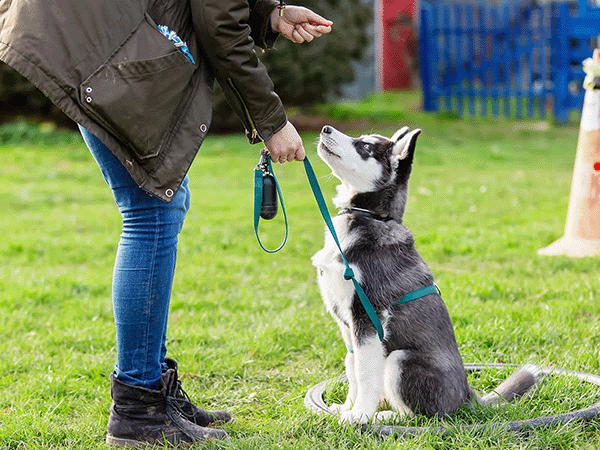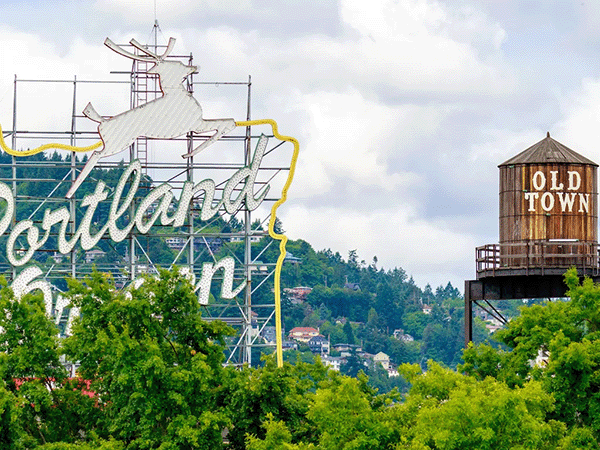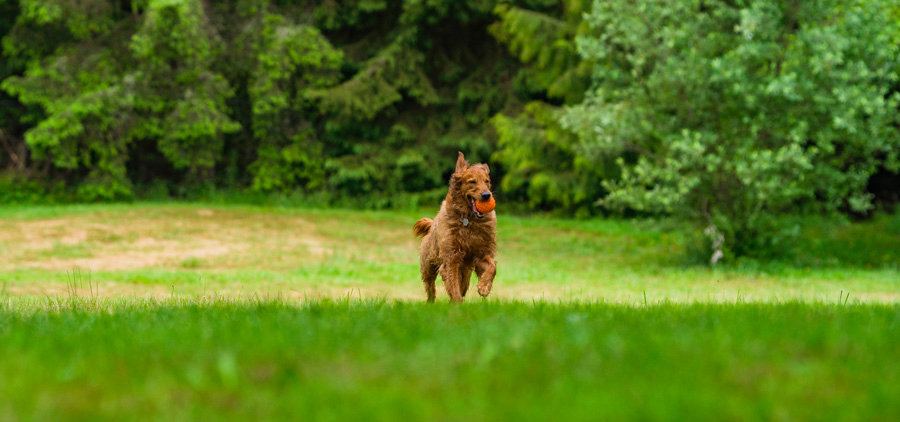Dog Enrichment Activities: The Ultimate Guide

Ever feel like your dog is restless or bored? They may be getting enough exercise, but still need more. That's where enrichment activities for dogs come in. Giving your dog opportunities to sniff, explore, and problem-solve can make a world of difference. Whether you have a puppy, adult, or senior dog, enriching their environment is key for their well-being. Let's explore how to add cognitive enrichment for dogs, even tailoring activities to your dog's breed with breed specific enrichment and fun enrichment games for dogs.
In today’s human society, these things come at a premium for our canine companions. While it’s important our pets can fit into our modern lives, it’s also important we meet their needs! Enter canine enrichment: A movement to provide our four-legged best friends with the kinds of experiences they evolved for—the activities that still bring them deep, instinctive joy. Proper mental and physical stimulation can be an important way to prevent unwanted behaviors and improve our pets’ overall quality of life.
We’ve put together a comprehensive guide to enrichment activities for our dogs. Here’s everything you need to know—and some easy enrichment ideas to get started!
What exactly is canine enrichment?
At its simplest, enrichment provides animals with opportunities to satisfy their innate urges. These activities “enrich” their lives by promoting mental and physical wellbeing!
If you ever visit a zoo or rehabilitated wildlife sanctuary, you might see signs and hear staff talk about the various forms of enrichment they provide their resident. In captivity caretakers usually make an effort to emulate an animal’s natural habitat so they can engage in instinctual behaviors.
While a domestic dog’s natural habitat is living around people—dogs coevolved with humans starting more than 15,000 years argo—it’s also true that we’ve come a long way from the early days of the canine-human partnership. Common enrichment activities usually give our dogs the chance to safely dig, sniff, and emulate their predatory sequence (searching, stalking, chasing, fighting, celebrating, and consuming) without harming or disrupting the communities we live in.
Key Takeaways
- Enrichment is more than just exercise: It's about meeting your dog's innate needs—sniffing, chewing, problem-solving—for a happier, healthier life.
- Every dog is different: Consider your dog's breed, age, and personality when choosing enrichment activities. Experiment to find what they love most!
- Enrichment doesn't have to be expensive: From DIY food puzzles to exploring new parks, there are plenty of affordable ways to keep your dog engaged and fulfilled.
Why is it important to provide enrichment for your dog?
Enrichment prevents boredom
Have you ever heard that a “tired dog is a good dog?” While exercise is important to keep our pets healthy, too much physical activity without appropriate mental stimulation can actually cause problems. We might create companions whose bodies never feel tired—and who have no idea how to slow down their brains! (Canines tend to develop cardio and muscle strength faster than humans do, so it’s easy to create a dog who can outlast us on the trails. And keeps outlasting us. Until we’re exhausted, puffing out of breath, while they’re still begging for more if we don’t want them to chew up the couch later.)
Enrichment activities can be the perfect solution here. Paired with appropriate physical exercise, things like food puzzles, snuffle mats, and thoughtful training sessions can keep your dog entertained without running either of you to the ground.
Sounds like a win-win to us!
Enrichment can relieve stress
Our modern world can also be overwhelming for our dogs. Their senses of hearing and smell are much more keen than ours. Stimuli we barely notice (like city sirens or apartment building air fresheners) might be absolutely deafening to our pets.
Natural behaviors like sniffing and chewing can help our dogs relieve anxiety and feel more comfortable with their surroundings. In fact, there’s evidence that sniffing lowers a dog’s heart rate even as they walk. What’s more? The simple behavior of eating—regular food or special treats—can also calm our dogs down.
Thoughtful enrichment can improve our pups’ stress levels.
Enrichment can build confidence
And enrichment activities don’t just reduce stress from potentially scary or overwhelming experiences. Mental stimulation can also build our dogs’ confidence in the first place! By learning to interact with a range of objects and move their bodies in various ways, our dogs learn that challenges aren’t scary—on the contrary, they often lead to good things.
This brings us to the importance of thoughtful socialization.
Enrichment can be a helpful part of puppy socialization
When we think of socialization, it’s easy to picture directly engaging with other people in social contexts: Talking with friends and family, playing games on a sports team, or heading to a work happy hour.
In reality, proper puppy socialization is more about exposure than interaction!
- Socialization isn’t only building social skills with people and other dogs (although that’s definitely part of it). It’s above all the process of getting our puppies used to things they might encounter throughout their lives so they can feel calm, confident, and capable.
- Because we live in a modern world designed for us people and not for our pets, the list of common things that might be scary to small puppies at first is long. Consider vacuum cleaners, tall people wearing hats, vacuum cleaners, loud sirens…
- A good way to think about socialization is helping puppies feel comfortable with a range of sights, sounds, smells, and surfaces.
So what does that all have to do with enrichment? Canine enrichment activities can be the perfect way to gradually expose your dog to new experiences in environments they’re already comfortable with! Instead of feeling pressured to chase all the unique socialization spots in your local community, you can provide puzzle toys or obstacle courses inside your own home.

Enrichment strengthens your bond
When we meet our dogs’ needs, we strengthen our relationship with them. Enrichment isn’t just about keeping our dogs busy—it’s about giving them appropriate outlets for their natural behaviors. This can reduce frustration for both of you. Activities like training with food puzzles or practicing scent work create opportunities for positive interactions. These shared experiences build trust and deepen your connection.
Plus, when your dog is happily engaged in an enriching activity, they’re less likely to engage in attention-seeking behaviors that can strain your relationship. A content dog is often a more relaxed and affectionate companion, leading to more quality time and cuddles on the couch.
Enrichment improves overall health and well-being
Enrichment is crucial for a dog's overall health and well-being. It's not enough to simply ensure our dogs get adequate exercise; they also need mental stimulation. Enrichment prevents boredom, which can manifest in destructive behaviors like excessive chewing or barking. It also provides an outlet for pent-up energy, reducing the risk of anxiety and stress.
Engaging in natural behaviors like sniffing, chewing, and licking can be incredibly calming for dogs. These activities tap into their innate instincts and provide a sense of comfort and control. Enrichment activities can also build confidence by presenting dogs with challenges they can overcome, leading to a greater sense of self-assurance and resilience in new situations. This can be especially beneficial for anxious or fearful dogs.
Every dog has unique enrichment needs
Every dog deserves enrichment—but the right enrichment activities aren’t one size fits all.
Different breeds might have certain instincts
- High drive, high energy working breeds will likely need more frequent and varied enrichment than pets bred solely for human companionship.
- Hounds generally love to use their noses, employing a strong sense of smell.
- Terriers are known for having intense prey and chase instincts.
- Herding breeds enjoy stalking and controlling behavior.
- Northern breeds often have a strong desire to run.
- Retrievers love to chase and carry objects.
When in doubt, get in touch with your breeder, rescue, or professional trainer. They’ll help you understand what your dog was bred to do and how you can fulfill their breed-specific needs!
Breed-Specific Enrichment Ideas
Because different breeds have different instincts and energy levels, it’s important to tailor enrichment activities to your dog’s specific needs. Here are some ideas based on common breed groups, according to Sniffspot’s research:
- High-Drive Working Breeds: These dogs need a lot of physical and mental exercise. Consider agility training, scent work, or even canicross if your dog loves to run. Visiting a safe, enriching space like those you can find on Sniffspot can also be a great option.
- Hounds: Focus on scent-based enrichment. Hide treats around the house or yard for your dog to find, or try a snuffle mat. You could even create a scent trail with dog-safe spices like cinnamon or cloves (always double-check spice safety for dogs).
- Terriers: These dogs thrive on activities that engage their prey drive. Try flirt poles, fetch with squeaky toys, or puzzle toys that dispense treats. Supervise play and make sure your terrier doesn't get overly fixated on any one toy or activity.
- Herding Breeds: Herding breeds often enjoy activities that involve controlling movement. Herding balls, agility courses, or even learning tricks like "go around" can be stimulating. Check out Sniffspot’s recommendations for the best toys for herding dogs.
- Northern Breeds: These dogs were bred for endurance and often love to run. Consider activities like skijoring, bikejoring, or even long walks or runs in a safe, open area. Sniffspot lists private dog parks where your northern breed can run freely.
- Retrievers: Retrievers love to fetch. Keep them entertained with games of fetch, retrieving dummies, or even dock diving if they enjoy the water. Sniffspot lists dog-friendly water parks where your retriever can swim and play.
Remember, these are just starting points. The best enrichment activities for your dog will depend on their individual personality, age, and health. If you’re not sure what your dog will enjoy, talk with a professional trainer or your veterinarian.
Your dog’s age influences what enrichment you should give them
- Puppies should avoid intense physical exercise until cleared by your veterinary team. It’s important to make sure their bones, muscles, and joints get the chance to develop properly.
- Young dogs, especially adolescents, might have a hard time focusing on the same activity for an extended period of time.
- Elderly dogs might struggle with tasks that involve precise or repetitive movements. Their brains might also struggle to process information at the speed they used to.
- Older dogs sometimes lose their senses of hearing and sight. Your pet’s abilities will dictate what types of sensory enrichment are the best fit for them.
Ultimately: Pay attention to what activities your own dog likes most
The opportunities to provide your dog with enrichment are pretty much endless. Just because your own canine companion might not like a popular toy, be as quick with certain games, or have the same preferences as your neighbor’s pet doesn’t mean there’s anything wrong with them. It simply means every animal is an individual!
Experiment with a few different enrichment activities to figure out what your own dog likes best.
Types of canine enrichment
We’ve broken down the main categories of enrichment for dogs—but it’s important to remember that many fun activities will overlap. The best outlets for our pups combine several of the below elements to provide as much fulfillment as possible!
Food enrichment
Food enrichment has become incredibly common. Most store-bought enrichment toys are specifically designed to feed our dogs’ meals in new and engaging ways!
Why the surge in popularity? For one thing, food puzzles are a great way for pet owners to test the enrichment waters. Every dog has to eat—and most of us have plenty of things already lying around the house that we can use to spruce up their meals. It’s often low effort but high impact.
Some examples of nutritional enrichment for your dog:
- Stuffed kongs (freezing them increases the difficulty) filled with peanut butter, wet food, plain greek yogurt, bone broth, or other pet-friendly concoctions
- Other frozen treats
- Scatter feeding their kibble
- Puzzle feeders, slow feeders, food-dispensing balls, or lick mats specifically designed to test our dogs’ skills (cardboard boxes, paper towel rolls, blankets, towels, and plastic bottles can be used to create simple homemade puzzles)
- Snuffle mats (tossing kibble or treats in the grass has a similar effect)
- Food searches where you hide meals or favorite treats around the house to create a nose work game (bonus if they’re smelly at first to make them easier to find)
DIY Food Enrichment Ideas
Food enrichment doesn’t have to be expensive. Some of the best food puzzles are made with common household items! Here are a few ideas to get you started:
- Muffin tin puzzle: Place a few small treats or kibble in each cup of a muffin tin. Then, cover each cup with a tennis ball or another small toy. Your dog will have to move the toys to get the treats.
- Towel burrito: Spread a thin layer of xylitol-free peanut butter or cream cheese on a towel. Roll the towel up tightly and let your dog unroll it to lick the filling.
- Cardboard box challenge: Cut a few small holes in a cardboard box and place treats or kibble inside. Your dog will have to figure out how to get the food out.
- Plastic bottle puzzle: Cut a few small holes in the sides of a plastic bottle and place treats or kibble inside. Make sure the holes are big enough for the food to fall out, but not so big that your dog can easily reach in and grab it. Secure the cap to prevent choking hazards.
Supervise your dog with any DIY toy, especially those made with plastic or other materials they could ingest. For more inspiration, check out this article on types of canine enrichment.
Scatter Feeding
Scatter feeding is a simple yet effective way to enrich your dog's mealtimes. Instead of putting their food in a bowl, scatter their kibble or treats across a designated area, like your backyard or a safe, enclosed Sniffspot. This encourages your dog to use their natural foraging instincts and provides mental and physical stimulation. It’s a great way to turn mealtime into a fun game!
For an extra challenge, scatter the food in different textures, like grass, leaves, or even a shallow kiddie pool (always supervise your dog around water). You can also hide some of the food under objects or in puzzle toys to make the search more engaging.
Puzzle Feeders
Puzzle feeders are a popular and convenient way to provide food enrichment. These toys come in various shapes and sizes, designed to challenge your dog to get the food out. They can be a great option for dogs who eat too quickly, as they slow down eating and prevent bloat.
Many types of puzzle feeders are available, from simple treat-dispensing balls to more complex puzzles with multiple compartments and challenges. You can even make your own using household items like cardboard boxes, paper towel rolls, or plastic bottles. This article has some great DIY puzzle feeder ideas. Choose a puzzle feeder that is appropriate for your dog's size, age, and skill level, and always supervise them while they are using it.
Cognitive enrichment
Giving our dog’s problem-solving challenges is a great way to productively wear them out and build relevant skills for navigating the world around us. These activities are commonly called mental stimulation. At their best, they work both our pets’ bodies and brains.
Some examples of cognitive enrichment for your dog:
- Formal training classes like obedience, rally, or agility
- At-home training sessions
- Learning new tricks and behaviors
- Impulse control exercises, like leaving treats until given permission to eat or waiting to chase a toy
- Nose work
- Puzzle toys
- Anything else that requires mental focus

Training and Trick Learning
Giving our dogs problem-solving challenges is a great way to productively wear them out and build relevant skills for navigating the world around us. These activities offer mental stimulation, working both their bodies and brains. Even basic obedience training, like sit, stay, and come, can be mentally tiring for a dog. It requires focus and impulse control. Plus, training strengthens the bond between you and your pup. A reliable recall can also give you peace of mind when you're out enjoying a Sniffspot together.
Don’t feel limited to traditional commands! Teaching your dog tricks can be just as enriching. Think shake, spin, play dead, or even more complex tricks like retrieving specific items. The possibilities are endless, and the learning process is mentally stimulating for your dog.
Scent Work: A Powerful Tool for Engagement
Scent work taps into a dog's natural instincts and provides a powerful form of enrichment. Sniffing and scavenging are deeply ingrained behaviors for dogs. Sniffing can even lower a dog's heart rate, helping them relax and de-stress. Think about how intently your dog sniffs every blade of grass on a walk. They're experiencing the world through their noses, gathering information, and processing scents.
You can create simple scent work games at home. Hide treats or toys around the house and let your dog use their nose to find them. You can also try formal nose work activities, where dogs learn to identify specific scents. This is a great way to challenge your dog mentally and physically, and it can be a lot of fun for both of you.
Problem-Solving Games and Puzzles
Problem-solving games and puzzles are another excellent way to provide cognitive enrichment. These can range from simple food puzzles, like a Kong stuffed with frozen peanut butter, to more complex interactive toys that require manipulation and problem-solving skills. Puzzle toys encourage your dog to think critically and figure out how to access a reward, whether it's a treat or a favorite toy. This mental exercise can be just as tiring as physical exercise, and it helps keep your dog's mind sharp.
When choosing puzzles, consider your dog's age, breed, and individual preferences. Start with easier puzzles and gradually increase the difficulty as your dog becomes more proficient. You can even create DIY puzzles using household items like cardboard boxes, muffin tins, or plastic bottles. The goal is to challenge your dog in a fun and engaging way, helping them develop problem-solving skills and build confidence. For a safe and enriching space where your dog can put these new skills to the test, explore the dog parks available on Sniffspot.
Physical enrichment
We addressed the potential dangers of too much physical activity (without appropriate mental outlets) above. But there’s no denying that exercise is important for our dogs to live their best lives! The key is to vary the type, length, and intensity of their activities to avoid creating a bored “super athlete.”
Some examples of physical enrichment for your dog:
- Flirt poles or spring poles
- Interactive games like fetch or tug-of-war
- Physical play like wrestling with you or other dogs
- Dog sports like skijoring, flyball, and more
- Homemade obstacle or agility courses
- Canine conditioning exercises
- A designated dig area
- Paper shredding
You can learn more about calculating your own dog’s unique exercise needs in this guide.
Walks and Hikes: Exploring New Environments
Going for a walk might seem basic, but it’s one of the easiest ways to enrich your dog’s life! As the Guide Dogs organization points out, taking your dog for a walk in a new environment exposes them to novel stimuli. Varying your dog’s walking route, letting them sniff freely, and changing the pace can make a world of difference.
Walks provide physical exercise, but they’re also a fantastic sensory experience for our canine companions. Dogs explore the world through their noses, and a simple walk gives them the chance to investigate all the interesting smells their neighborhood has to offer. Even better? Studies show that sniffing can lower a dog’s heart rate, reducing stress and promoting relaxation.
If your dog enjoys longer outings, consider taking them on hikes in dog-friendly natural areas. Hiking provides excellent physical and mental stimulation, allowing your dog to explore different terrains, navigate obstacles, and enjoy the sights, sounds, and smells of nature. Just remember to check the rules and regulations of your chosen trail before you go.
Fetch and Play: Engaging in Energetic Activities
A good game of fetch is a classic for a reason. It combines physical exercise with mental stimulation, satisfying your dog’s natural instincts to chase and retrieve. Interactive games like fetch or tug-of-war are important for our dogs! Varying the type of toy—from tennis balls to frisbees to squeaky toys—can keep things interesting for both of you.
Tug-of-war can also be a fun and engaging activity, but it’s important to establish clear rules to prevent over-excitement or potential injury. Teach your dog to “take it” and “leave it” on command, and avoid playing tug-of-war with puppies or dogs with dental issues.
Beyond fetch and tug-of-war, there are plenty of other energetic activities to enjoy with your dog. Consider playing hide-and-seek in your backyard, setting up a mini agility course, or teaching your dog new tricks like jumping through hoops or weaving through cones. These activities provide both physical and mental challenges, keeping your dog entertained and engaged.
Swimming and Water Play: A Refreshing Option
If your dog loves the water, swimming can be a fantastic form of enrichment. As the ASPCA notes, swimming provides exercise and a refreshing experience. It’s a low-impact activity that’s gentle on their joints, making it a great option for dogs of all ages and physical abilities. Just make sure to supervise your dog closely around water and ensure they have a safe way to enter and exit pools, lakes, or other bodies of water.
Even if your dog isn’t a strong swimmer, they can still enjoy water play. Consider providing a shallow kiddie pool, a sprinkler, or a water hose for them to splash around in. You can also toss floating toys into the water for them to retrieve, adding an element of fetch to their water play.
Remember to introduce your dog to water gradually, especially if they’re hesitant or unsure. Start with shallow water and gradually increase the depth as they become more comfortable. Never force your dog into water if they’re scared or unwilling.
Finding the Perfect Dog Park with Sniffspot
Dog parks can be a great way for your dog to socialize, exercise, and explore new environments. Sniffspot offers a unique way to find the perfect dog park for your pup. With listings for private and public dog parks across various cities, you can easily find a safe and stimulating space for your dog to play and interact with other dogs. Sniffspot even lists dog parks with special amenities, like water features, so you can find the perfect spot for a refreshing dip on a hot day.
When visiting a dog park, it’s important to observe your dog’s behavior and ensure they’re interacting appropriately with other dogs. If your dog becomes overwhelmed or shows signs of stress, it’s always okay to remove them from the situation and try again another time. You can also use Sniffspot to find dog parks that cater to specific needs, such as parks for small dogs or parks with separate areas for shy or reactive dogs.
Beyond dog parks, Sniffspot also offers a variety of other dog-friendly locations, including private dog parks, hiking trails, and even indoor play spaces. With so many options available, you’re sure to find the perfect spot for your dog to enjoy some enriching outdoor adventures. And if you have a dog-friendly space of your own, consider becoming a host on Sniffspot to share it with other dog lovers in your community.
Social enrichment
Dogs are social mammals. While not every dog loves strange people or other animals—and there’s absolutely no reason they need to!—it is important to provide our pets with plenty of opportunities for social interaction with family members and friends.
Some examples of social enrichment for your dog:
- Hide and seek with you
- Playdates with furry friends if they enjoy the company of other dogs (Sniffspots can be a great way to safely set up meetings with pet parents you trust)
- Social play with family members
- Intentional social time (like giving a canine massage)

Playdates with Other Dogs
If your dog enjoys the company of other canines, playdates can be a great way to provide social enrichment. Choose playmates wisely, opting for dogs whose temperament and play style are a good match for your pup. Sniffspot can be a fantastic resource for finding safe and private locations to host playdates with dogs whose owners you know and trust. This allows for controlled interactions in a secure environment, letting your dog socialize on their own terms.
Doggy Daycare or Boarding
For dogs who thrive in social settings, doggy daycare or boarding can offer valuable opportunities for interaction with other dogs and people. A reputable facility will prioritize safety and provide appropriate supervision, ensuring a positive experience for your dog. Daycare can be a particularly good option for dogs who need regular social interaction, while boarding can provide enrichment during times when you're away from home. Just as with playdates, it's important to choose a facility that's a good fit for your dog's personality and needs. Prioritizing your dog's comfort is key to successful socialization.
Socialization at Dog Parks
Dog parks can be a fun way for dogs to socialize and burn off energy, but they're not the right environment for every dog. If you choose to take your dog to a dog park, observe their body language closely to ensure they're comfortable and enjoying the experience. Be prepared to intervene if necessary, and always supervise your dog closely. If your dog seems overwhelmed or stressed, it's best to remove them and explore other options for social enrichment. A positive experience is crucial for healthy socialization.
Quality Time with You
Sometimes, the best social enrichment for a dog is simply spending quality time with their favorite person—you! This could involve anything from cuddling on the couch to playing a game of fetch in the backyard. Even simple activities like giving your dog a massage can be a powerful way to strengthen your bond and provide them with the social interaction they crave. Intentional, focused time with your dog can be just as enriching as interactions with other dogs, and it's a crucial part of building a strong and loving relationship.
Sensory enrichment (also known as environmental enrichment)
Our dogs have the same main senses we do (though their abilities differ—human eyes are better in the daylight while canine noses and ears put our own to shame). To change up your dog’s enrichment, spend some time thinking about what they see, hear, smell, taste, and feel! After all, variety is the spice of life.
Some examples of sensory enrichment for your dog:
- Sitting and watching the world go by in a public space (parks are great for this)
- Varying the type, size, and taste of the treats they eat
- Using lots of different materials to make your own puzzle toys
- Rolling in the grass
- Playing bird sounds, classical music, or gentle wind chimes in the background (you can experiment with different types of music, but we know classical music specifically because it might be therapeutic)
- Setting up a sensory scent garden in your yard with dog-friendly herbs (bonus if this garden includes some of the auditory enrichment mentioned above)
Visual Stimulation: Bubbles, Birdwatching, and New Scenery
One of the easiest ways to provide visual enrichment is simply changing your dog’s environment. While daily walks around the neighborhood are great for physical and olfactory stimulation (more on that below!), sometimes our dogs benefit from a change of pace. A trip to a new park, a visit to a dog-friendly store, or even just sitting outside on the porch can give your pup plenty of interesting things to look at. If you’re looking for a safe, enriching space for your dog to explore, check out the dog parks available on Sniffspot.
You can also introduce engaging visual stimuli at home. Bubbles (make sure they’re non-toxic!) can be a fun way to encourage your dog to practice their eye-paw coordination. If your dog enjoys watching birds from the window, consider setting up a bird feeder in your yard. Even something as simple as rearranging the furniture in your living room can create a sense of novelty and encourage exploration.
Auditory Stimulation: Music, Nature Sounds, and Talking to Your Dog
Sound is another important sense to consider when it comes to canine enrichment. Just like us, our dogs react to different sounds in different ways. While some noises might be startling or upsetting, others can be calming and enjoyable. Experiment to see what your dog likes best! Many dogs enjoy listening to calming music, like classical or reggae. Studies have shown that classical music can have a relaxing effect on dogs in shelters, reducing stress-related behaviors like barking and pacing.
Try playing nature sounds, such as birdsong or rain. Even talking to your dog in a soothing voice can be enriching. Playing bird sounds, classical music, or gentle wind chimes in the background can create a calming atmosphere. You can experiment with different types of music. If you host on Sniffspot, consider adding some wind chimes to enhance the auditory experience for visiting dogs.
Tactile Stimulation: Different Textures, Massage, and Grooming
Don’t forget about your dog’s sense of touch! Tactile enrichment can involve a variety of textures and sensations. Using lots of different materials to make your own puzzle toys can provide tactile stimulation, engaging your dog's sense of touch and encouraging exploration. Consider offering toys made of different materials, like rubber, rope, or soft plush. Activities like gentle massage or brushing can be both relaxing and stimulating.
Some dogs enjoy having their paws handled and nails trimmed, especially with gradual and positive introductions from a young age. If your dog enjoys rolling in the grass, create a designated area in your yard where they can indulge without getting muddy or tracking dirt into the house. You can also hide treats or toys in a pile of blankets or towels for your dog to discover, providing both tactile and cognitive stimulation.
Olfactory Stimulation: Scent Trails, Herbs, and New Smells
For many dogs, smell is their most powerful sense. Olfactory enrichment can be incredibly engaging and satisfying. One easy way to provide olfactory enrichment is taking your dog on walks in new and interesting places. This allows them to explore a variety of scents and experience the world through their nose. Sniffspot offers a variety of locations for safe and enriching walks.
You can also create scent trails in your yard or home using treats or essential oils (make sure any essential oils you use are dog-safe!). Hiding treats or toys for your dog to find is another great way to engage their sense of smell and provide mental stimulation. If you host on Sniffspot, consider adding a variety of natural scents to the environment, such as cedar chips, pine needles, or lavender. Make sure any scents you introduce are safe for dogs and won’t irritate their sensitive noses.
Dogs make our lives better—let’s enrich theirs, too
Anyone who has known the love of a dog will tell you that they make our lives better. They help us learn new skills, meet more people, embrace novel challenges, and ultimately become stronger, smarter, more caring people.
It’s the least we can do to enrich their daily lives, too!
Trainer Review of this Article
There is so much misinformation out there, we want to make sure we only provide the highest quality information to our community. We have all of our articles reviewed by qualified, positive-only trainers.
This is the trainer that reviewed this article:
Beth Joy, CPDT-KA, PMCT
Owner and Lead Trainer Unleashed Joy Dog Training – Mt. Airy, MD.
Certified Professional Dog Trainer (CPDT-KA)
www.unleashedjoy.com
DIY Enrichment Ideas for Every Budget
One of the best things about canine enrichment? It doesn’t have to be expensive! Many of the most effective enrichment activities use recycled or easily accessible materials. Here are a few ideas to get you started.
Low-Cost Options: Repurposing Household Items
Before you rush out to buy the latest puzzle toy, take a look around your house. Chances are you already have plenty of items you can repurpose for canine enrichment! Empty egg cartons and paper towel rolls can become simple food puzzles. Just fill them with treats and let your dog figure out how to get them out. Old towels or blankets can be used for tug-of-war, hide-and-seek, or even a simple scent work game. Just remember to supervise your dog with any DIY toy and remove it if they try to swallow it.
Moderate Investments: Durable Toys and Interactive Games
If you’re willing to spend a little money, durable chew toys, lick mats, and puzzle toys are all great options. Many DIY options can also help you save money. You can create your own snuffle mat from an old towel or blanket, or build a simple agility course in your backyard using PVC pipes or other household materials. Food puzzles are a great way to test the enrichment waters, and you can find a variety of them at most pet stores. If you're looking for a safe space for your dog to enjoy some enrichment activities, check out Sniffspot's listings of dog parks near you.
Premium Choices: Advanced Puzzles and Subscription Boxes
For pet parents looking for a more premium enrichment experience, there are plenty of advanced puzzles and subscription boxes on the market. These can be a great way to keep your dog challenged and engaged, and they often come with new and interesting toys and treats. These activities provide excellent mental stimulation, working both your pet’s body and brain. Just remember that even with premium toys, supervision is key.
Creating a Balanced Enrichment Plan for Your Dog
The most effective enrichment plans combine various activities to meet your dog’s individual needs. Think about incorporating food puzzles, cognitive games, physical exercise, social interaction, and sensory experiences. A balanced approach will keep your dog happy, healthy, and engaged. For example, after a stimulating play session at a Sniffspot dog park, wind down with a calming puzzle toy at home.
The Importance of Supervision During Enrichment Activities
Supervision is crucial for any enrichment activity, especially those involving DIY toys. Always monitor your dog to ensure they are playing safely and not ingesting anything they shouldn’t. Remove any toy if your dog starts to chew on it destructively or tries to swallow pieces. Safety first!
Troubleshooting Common Enrichment Challenges
Sometimes, even the best-laid enrichment plans can hit a snag. If your dog seems uninterested in an activity, try making it easier or more rewarding. Unstimulated dogs often develop behavioral problems, so finding activities they enjoy is important. You can also try rotating toys and activities regularly to keep things fresh and exciting. Making mealtimes interactive and challenging is another great way to add enrichment to your dog’s day. If you're struggling to find enriching activities your dog enjoys, consider consulting a professional dog trainer.
Related Articles
- Comprehensive Guide to Enrichment Activities for Dogs
- Top Dog Enrichment Toys: Keep Your Pup Happy & Engaged
- 20+ Best Enrichment Toys for Dogs: Ultimate Guide
Frequently Asked Questions
My dog isn't interested in any of the enrichment activities I've tried. What should I do? It's totally normal for dogs to have different preferences! If your dog seems uninterested in a particular activity, try adjusting the difficulty level. Make it easier at first, then gradually increase the challenge as they get the hang of it. Upping the reward value can also help – try extra tasty treats or a super special toy. Keep trying different things until you find something they truly enjoy. Variety is key, so rotate toys and activities regularly to keep things fresh and exciting. If you're still having trouble, consider consulting a professional dog trainer for personalized guidance.
Is enrichment only for bored dogs? Absolutely not! Enrichment is for all dogs. While it's definitely helpful for preventing boredom, it also offers so many other benefits. Enrichment can reduce stress, build confidence, and even help with socialization. It's all about giving your dog opportunities to engage in natural behaviors, which is important for their overall well-being.
My dog is a senior. Are there specific enrichment activities that are good for older dogs? Yes! For senior dogs, it's important to choose activities that are appropriate for their physical limitations. Low-impact activities like gentle scent work, puzzle toys with larger pieces, and short, easy walks are great options. Consider their senses, too. If their vision or hearing isn't what it used to be, focus on tactile or scent-based enrichment. Always check with your vet before starting any new activity with a senior dog.
How much enrichment does my dog need? There's no magic number, as every dog is different. Factors like breed, age, energy level, and individual personality all play a role. A good starting point is to aim for a few short enrichment sessions throughout the day. Observe your dog closely – if they seem restless, destructive, or anxious, they might need more enrichment. If they seem tired or overwhelmed, they might need less.
What's the difference between enrichment and training? While they can overlap, enrichment and training have distinct goals. Training focuses on teaching specific behaviors and commands, while enrichment focuses on providing opportunities for natural behaviors and mental stimulation. Think of it this way: training is like school, while enrichment is like playtime. Both are important for a well-rounded dog! Many enrichment activities, like puzzle toys and scent work, can actually incorporate training elements, making them even more beneficial.
Most recent articles
Related articles
Top dog guides per area
Dog training guides

Dog Food Aggression: Why You Shouldn't Punish It
Does your dog ever growl when you walk by their food dish? Maybe they get possessive of treats, carrying them far away and giving you side-eye when you start to approach — or snarling at your other pets or children if they get too close.

Best Dog Fields in the US: 25+ Wide-Open Spaces for Your Pup to Run Free
The best dog fields in the US offer something that traditional enclosed parks simply can't match: acres of open space where your pup can truly stretch their legs and run at full speed. From Colorado's 470-acre prairie meadows to Tennessee's award-winning "Outback," these wide-open spaces allow dogs to roam, explore, and exercise naturally while engaging instincts that cramped urban parks suppress.

The Ultimate Guide to Scent Training for Dogs
Your dog's nose is an amazing tool. Did you know they have 40 times the olfactory receptors than humans? Scent training for dogs taps into this superpower, turning everyday moments into exciting sniff-fests. It's enriching for all types of dogs – reactive, shy, or simply adventurous. Ready to explore the world of scent work for dogs? Let's get started.

Service Dog Training Costs: DIY vs. Pro
More than 80 million Americans rely on their service dogs to help them navigate the world. Task-trained assistance animals perform a huge range of life-changing—in many cases, life-saving—services: These dogs act as eyes for visually impaired handlers, provide mobility support, alert to seizures and blood sugar crashes, interrupt anxiety attacks, remind their people to take medications, and so much more.

How to Deal With Puppy Potty Training Regression
You thought those dreaded middle-of-the-night potty breaks were over. You were finally free from cleaning up puppy puddles. Then, suddenly, your furry friend starts having accidents again. It's frustrating, right? This puppy potty training regression is more common than you think. Don't worry; we'll help you get your pup back on track. We'll cover the common causes, offer practical solutions, and give you actionable steps to tackle this challenge together.

Dirty Dog Syndrome: Causes, Solutions, and Prevention
It's a cringe-worthy moment every dog owner dreads: your furry friend chowing down on something truly disgusting. If your dog has a penchant for poop, you're dealing with coprophagia. It's more common than you think, and thankfully, often manageable. This article explores the reasons behind dirty dog syndrome, from instinct to learned behavior. We'll also give you practical tips to help break this unpleasant habit.

How to Train Your Rescue Dog: A Complete Guide
* All Sniffspot articles are reviewed by certified trainers for quality, please see bottom of article for details *
Dog enrichment guides

Best Dog Water Parks in the US: 15+ Amazing Splash Destinations for Your Pup
Do you have a water-loving dog looking to burn some energy? There are countless dog parks to visit throughout our country — but some of them become far too hot in the midday sun to be safe for your pets to play. That’s why we’ve put together a list of some of the best dog water parks throughout the United States! At these locations, your pup can frolic, splash, and swim to their heart’s content.

Best Dog Fields in the US: 25+ Wide-Open Spaces for Your Pup to Run Free
The best dog fields in the US offer something that traditional enclosed parks simply can't match: acres of open space where your pup can truly stretch their legs and run at full speed. From Colorado's 470-acre prairie meadows to Tennessee's award-winning "Outback," these wide-open spaces allow dogs to roam, explore, and exercise naturally while engaging instincts that cramped urban parks suppress.

Best Toys for Herding Dogs: Keeping Your Pup Happy & Engaged
Herding dogs are amazing, intelligent companions. But that also means they need more than just a simple game of fetch. Finding the right toys for herding dogs is key to keeping them happy and stimulated. This article explores some of the best toys for herding dogs, including options specifically for breeds like Border Collies and Australian Shepherds. We'll help you discover the perfect herding toys for dogs to tap into their natural instincts and keep them entertained for hours.

Tough Dog Toys for Aggressive Chewers: A Practical Guide
Does your dog destroy every toy you give them? Is your house littered with the remnants of plush toys? Are you tired of wasting money on "indestructible" dog toys for aggressive chewers that don't last? Then this post is for you. We'll cover everything you need to know about finding the best dog toys for aggressive chewers, so you can finally give your pup something safe, durable, and fun.

Daily Exercise Calculator: How Much Exercise Does Your Dog Need?
Everyone knows dogs need exercise, but how much is enough? Walks are great, but creating a truly balanced fitness plan means understanding your dog's specific needs. This post helps you develop a daily exercise calculator for your dog, considering breed, age, and lifestyle. We'll cover fun activities, understanding exercise intensity, and recognizing when your pup has had enough. Let's create a plan that keeps your dog happy and healthy!

Complete Guide To Herding With Dogs
* All Sniffspot articles are reviewed by certified trainers for quality, please see bottom of article for details *

Dog Enrichment Activities: The Ultimate Guide
Ever feel like your dog is restless or bored? They may be getting enough exercise, but still need more. That's where enrichment activities for dogs come in. Giving your dog opportunities to sniff, explore, and problem-solve can make a world of difference. Whether you have a puppy, adult, or senior dog, enriching their environment is key for their well-being. Let's explore how to add cognitive enrichment for dogs, even tailoring activities to your dog's breed with breed specific enrichment and fun enrichment games for dogs.
Dog reactivity guides

Rottweiler Aggression: Truth vs. Myth
Many dogs have gotten a bad reputation over the years for being "dangerous breeds." Rottweilers are among them. Like pit bulls and other large, blocky-headed types of dogs, these powerful and beautiful animals are often assumed to be aggressive.

Best Dog Fields in the US: 25+ Wide-Open Spaces for Your Pup to Run Free
The best dog fields in the US offer something that traditional enclosed parks simply can't match: acres of open space where your pup can truly stretch their legs and run at full speed. From Colorado's 470-acre prairie meadows to Tennessee's award-winning "Outback," these wide-open spaces allow dogs to roam, explore, and exercise naturally while engaging instincts that cramped urban parks suppress.

What Is a Reactive Dog? A Practical Guide for Owners
Does your dog suddenly transform into a barking, lunging Tasmanian devil on walks? It's stressful for both of you. If this sounds familiar, you might have a reactive dog. Understanding what is a reactive dog is the first step to calmer walks. We'll explore the common triggers and give you actionable strategies to manage and modify this behavior. Let's turn those stressful walks into enjoyable outings.

How to Socialize a Reactive Dog: A Step-by-Step Guide
Does your dog display reactivity to other pets or people? Maybe they’re a new rescue pup and are still settling into your home. Or they were sick growing up, so you missed their critical socialization period. Possibly they’ve had a bad experience after being raised as a normal puppy.

What Is a Reactive Dog? A Complete Guide
Is your dog overly excited or fearful around other dogs? Do they bark, lunge, or whine? You might have a reactive dog. Many dog owners face this challenge. Understanding what a reactive dog is is the first step to helping them. This guide explores the common causes of dog reactivity, explains what makes a dog reactive, and offers practical tips and resources. Let's work together to build a stronger bond with your dog and enjoy stress-free walks.

9 Best Online Communities for Reactive Dog Parents
Does your dog's reactivity make walks stressful? You're not alone. Many dog owners face similar challenges. This guide offers practical advice and support for managing reactivity, including finding the best online dog training for reactive dogs. We'll connect you with reactive dog support groups, share training tips, and explore resources like the best dog training app for reactive dogs. Let's build a stronger bond with your dog, together.
* All Sniffspot articles are reviewed by certified trainers for quality, please see bottom of article for details *
How To Groom a Reactive Dog
* All Sniffspot articles are reviewed by certified trainers for quality, please see bottom of article for details *
Sniffspot community guides

The State of Public Dog Parks Across the United States
From 2009 to 2020, there was a 40 percent increase in the development of public dog parks. Designated spots for canine exercise have become commonplace in every major city in North America — many pet owners won’t even consider renting an apartment that doesn’t have its own fenced-in pet area for their canine companions.

Best Dog Fields in the US: 25+ Wide-Open Spaces for Your Pup to Run Free
The best dog fields in the US offer something that traditional enclosed parks simply can't match: acres of open space where your pup can truly stretch their legs and run at full speed. From Colorado's 470-acre prairie meadows to Tennessee's award-winning "Outback," these wide-open spaces allow dogs to roam, explore, and exercise naturally while engaging instincts that cramped urban parks suppress.

How This Family is Affording Their Dream Property Through Renting it Hourly to Dogs
Thousand Oaks, California has been a safe haven for Sniffspot host, Jen, since childhood. Having grown up in busy Santa Barbara, Jen, an introvert from an early age, would seek out solitude and serenity away from tourists attractions and droves of people visiting from elsewhere. “My grandparents own 60 acres about a 30 minute drive from here, and I grew up spending every summer and every holiday visiting them on the ranch,” Jen explained. “In Santa Barbara, we wouldn't go to the beach on the weekend because that's where everybody was, so you'd find places off the beaten path where the tourists weren't. For me, the ranch was just my happy place.”

Host Tips: Ellen K. What Makes Sniffspot Successful for Me
Ellen is the host of Country Pasture Getaway, one of Sniffspot's most popular sniff spots. She has taken the time to write up the lessons she has learned about how to be a great sniff spot host.

How this Oregon Farmer is Making a Business From Renting Her Land to Dogs
Just 20 minutes outside of the busy city of Portland, Oregon, and settled right on the banks of the Columbia River, you’ll find what countless visitors have flocked to the area in search of – mountain views, crisp, clean air, and running water for miles. What you might not expect to find, however, is a hidden oasis designed just for dogs and their people, owned and operated by a farming couple and enjoyed by visitors on two legs, and four.

Host Tips: Fran T. Providing Great Guest Service at our Spot
Fran is the host of Ranch Setting, one of Sniffspot's most popular spots. She has taken the time to write up the lessons she has learned about how to be a great Sniffspot host.

How Sniffspot Helped a Nervous Rescue Work Through His Fears and Change His Family’s Life
This is the story of a family and dog rescuing each other.
Top dog trainers in the US

The Best Dog Trainers in the United States of 2026
This is a list of the top dog trainers in the United States, based on votes from the Sniffspot community and the general public.
The Best Dog Trainers in Seattle, WA of 2026
This is a list of the top dog trainers in Seattle, WA, based on votes from the Sniffspot community and the general public.
The Best Dog Trainers in Portland, OR of 2026
This is a list of the top dog trainers in Portland, OR, based on votes from the Sniffspot community and the general public.
The Best Dog Trainers in Los Angeles, CA of 2026
This is a list of the top dog trainers in Los Angeles, CA, based on votes from the Sniffspot community and the general public.
The Best Dog Trainers in New York, NY of 2026
This is a list of the top dog trainers in New York, NY, based on votes from the Sniffspot community and the general public.
City dog parks guides

Top 10 Indoor Dog Parks: A US Guide
Looking for a space to play with your dog no matter what the weather’s like outside? Look no further than our list of the best indoor dog parks in the United States! These climate-controlled spaces are growing in popularity as pet ownership increases throughout the country. As a bonus, many of them also offer dog training, boarding, grooming, or daycare services on the premises.

Best Dog Fields in the US: 25+ Wide-Open Spaces for Your Pup to Run Free
The best dog fields in the US offer something that traditional enclosed parks simply can't match: acres of open space where your pup can truly stretch their legs and run at full speed. From Colorado's 470-acre prairie meadows to Tennessee's award-winning "Outback," these wide-open spaces allow dogs to roam, explore, and exercise naturally while engaging instincts that cramped urban parks suppress.

Best Dog Parks in the US: Ultimate Guide to Public & Private Off-Leash Adventures
Is your pup giving you those pleading "let me run free" eyes? Whether you're a new dog parent or a seasoned pro looking for fresh adventures, finding the perfect off-leash paradise for your furry friend can feel ruff! From sun-soaked California beaches where your water-loving lab can make a splash to mountain trails in Vermont where your adventure buddy can chase every scent, we've sniffed out the 15 best dog parks across America.

Dog Parks Near Me: Las Vegas Edition
Looking for the perfect dog park near me in Las Vegas? You're in luck! This guide explores all the best options for your pup, from public dog parks to private dog parks near me on Sniffspot. We'll help you find the ideal spot for playtime, socializing, and fresh air. Plus, we'll cover essential etiquette and safety tips to ensure a happy visit for everyone. Get ready for some tail-wagging fun!

Top Sniffspot Locations: Find the Perfect Dog Park
Looking for the perfect dog park? Whether you need a wide-open public space or a private, fenced-in spot, this guide will help you find the best dog parks across the US. We'll cover top-rated public parks, the perks of private dog parks, and even explore Sniffspot locations – giving your pup a safe and fun place to play. Ready to find your dog's new favorite spot? Let's go!

Sniffspot: Portland's Best Private Dog Parks
Ready to discover Portland's best dog parks? Whether you're looking for a public park or the unique experience of a private Sniffspot, this guide has you covered. We'll help you find the perfect spot for your pup, with tips on what to bring, how to prepare, and even understanding dog body language. Plus, we'll explore some top Portland dog parks, including public and Sniffspot options, so you can plan your next dog-friendly adventure in the City of Roses.
Portland Dog Parks: Public & Private Options
This page is about public city dog parks and also includes Sniffspot private dog parks. Sniffspot is the largest network of private dog parks for rent in the world!
Small Dog Park Guide: Tips for Finding the Perfect Spot
Finding the perfect dog park for your small breed can be ruff! Big dog parks can be overwhelming, even dangerous, for little pups. This comprehensive guide helps you sniff out the best small dog parks for your pint-sized companion, covering everything from essential safety checklists to top recommendations for small dog parks across the US—including both public spots and private dog parks.
Dogs breeds

German Shepherd Guide: Best Family Dog? Truth from 9K Owners
The German Shepherd Dog (GSDs) are known for their intelligence, loyalty, and striking appearance. They're also incredibly versatile, excelling as working dogs and devoted family companions. This guide covers everything you need to know about GSDs, from understanding their unique traits and rich history to practical advice on training and care. So, whether you're a seasoned GSD owner or just starting your research, let's explore this remarkable breed together.

Best Dog Fields in the US: 25+ Wide-Open Spaces for Your Pup to Run Free
The best dog fields in the US offer something that traditional enclosed parks simply can't match: acres of open space where your pup can truly stretch their legs and run at full speed. From Colorado's 470-acre prairie meadows to Tennessee's award-winning "Outback," these wide-open spaces allow dogs to roam, explore, and exercise naturally while engaging instincts that cramped urban parks suppress.

Labrador Retriever: America's Best Family Dog? Owner Truth
Discover the Labrador Retriever, a breed celebrated for its playful nature, affectionate temperament, and trainability. Labradors are known for their friendly demeanor and adaptability, making them perfect family companions and versatile working dogs. As one of the most popular types of retrievers, Labs are ideal companions for various lifestyles and are recognized by the American Kennel Club (AKC) as an excellent breed for families.

Golden Retriever Advice: The Complete Owner's Guide
Golden Retrievers: they're gorgeous, playful, and incredibly popular. But before you welcome one into your home, you need the right golden retriever advice. This guide draws on the wisdom of nearly 10,000 Golden Retriever owners, offering practical tips for caring for these affectionate dogs. From understanding their high energy levels to mastering grooming and training, we'll cover everything you need to know. So whether you're already a devoted Golden parent or just starting your research, get ready to learn how to give your furry friend the best possible care.

Are American Staffordshire Terriers Good for First-Time Owners: Complete Guide
Think American Staffordshire Terriers are tough? Think again. While their muscular build might intimidate some, these dogs are known for their playful and loyal personalities. This guide draws on the experience of nearly 10,000 AmStaff owners to reveal the truth about this often misunderstood breed. Want to learn more about caring for an American Staffordshire Terrier? You're in the right place.

Australian Shepherd Facts: Breed Info & Care Guide
Discover the Australian Shepherd, an AKC breed celebrated for its trainable, playful, and affectionate nature. Despite its name, the Australian Shepherd is actually a native breed to the United States, originally developed to breed on farms and ranches. Considered a medium dog, Australian Shepherds were bred for herding beginning in the 1950s. As one of the high-energy breeds, Aussies are known for their boundless energy and need for regular exercise, including aerobic exercise.

Essential Husky Facts for Owners: Breed Guide
Discover the Siberian Husky, a breed celebrated for its curious, intelligent, and loyal nature. Considered a medium-sized dog, Siberian Huskies were originally bred in Russia for sledding, beginning in the early 20th Century. Today, they're one of the most popular active breeds in North America.






























